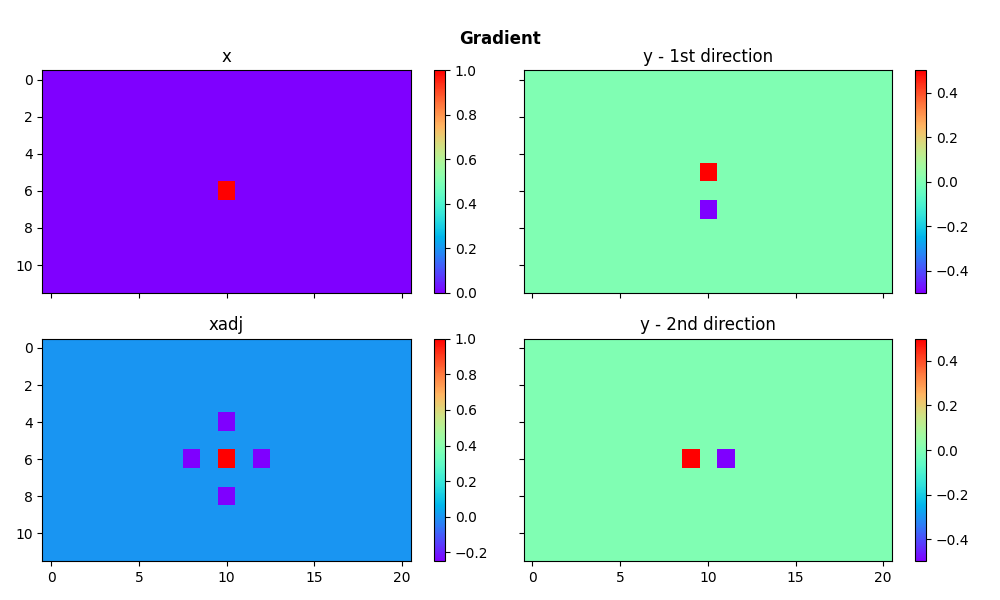Note
Go to the end to download the full example code.
Derivatives#
This example demonstrates how to use pylops-mpi’s derivative operators, namely
pylops_mpi.basicoperators.MPIFirstDerivative,
pylops_mpi.basicoperators.MPISecondDerivative and
pylops_mpi.basicoperators.MPILaplacian.
We will be focusing here on the case where the input array \(x\) is assumed to be
an n-dimensional pylops_mpi.DistributedArray and the derivative is
applied over the first axis (axis=0). Since the array is distributed
over multiple processes, the derivative operators must take care of applying
the derivatives across the edges using the information from the previous/next
processes, using the so-called ghost cells.
Derivative operators are commonly used when solving inverse problems within regularization terms aimed at enforcing smooth solutions
from matplotlib import pyplot as plt
import numpy as np
from mpi4py import MPI
import pylops_mpi
plt.close("all")
np.random.seed(42)
rank = MPI.COMM_WORLD.Get_rank()
size = MPI.COMM_WORLD.Get_size()
Let’s start by applying the first derivative on a pylops_mpi.DistributedArray
in the first direction(i.e. along axis=0) using the
pylops_mpi.basicoperators.MPIFirstDerivative operator.
nx, ny = 11, 21
x = np.zeros((nx, ny))
x[nx // 2, ny // 2] = 1.0
Fop = pylops_mpi.MPIFirstDerivative((nx, ny), dtype=np.float64)
x_dist = pylops_mpi.DistributedArray.to_dist(x=x.flatten())
y_dist = Fop @ x_dist
y = y_dist.asarray().reshape((nx, ny))
if rank == 0:
fig, axs = plt.subplots(1, 2, figsize=(10, 3), sharey=True)
fig.suptitle(
"First Derivative in 1st direction", fontsize=12, fontweight="bold", y=0.95
)
im = axs[0].imshow(x, interpolation="nearest", cmap="rainbow")
axs[0].axis("tight")
axs[0].set_title("x")
plt.colorbar(im, ax=axs[0])
im = axs[1].imshow(y, interpolation="nearest", cmap="rainbow")
axs[1].axis("tight")
axs[1].set_title("y")
plt.colorbar(im, ax=axs[1])
plt.tight_layout()
plt.subplots_adjust(top=0.8)

We can now do the same for the second derivative using the
pylops_mpi.basicoperators.MPISecondDerivative operator.
nx, ny = 11, 21
x = np.zeros((nx, ny))
x[nx // 2, ny // 2] = 1.0
Sop = pylops_mpi.MPISecondDerivative(dims=(nx, ny), dtype=np.float64)
x_dist = pylops_mpi.DistributedArray.to_dist(x=x.flatten())
y_dist = Sop @ x_dist
y = y_dist.asarray().reshape((nx, ny))
if rank == 0:
fig, axs = plt.subplots(1, 2, figsize=(10, 3), sharey=True)
fig.suptitle(
"Second Derivative in 1st direction", fontsize=12, fontweight="bold", y=0.95
)
im = axs[0].imshow(x, interpolation="nearest", cmap="rainbow")
axs[0].axis("tight")
axs[0].set_title("x")
plt.colorbar(im, ax=axs[0])
im = axs[1].imshow(y, interpolation="nearest", cmap="rainbow")
axs[1].axis("tight")
axs[1].set_title("y")
plt.colorbar(im, ax=axs[1])
plt.tight_layout()
plt.subplots_adjust(top=0.8)

We now use the pylops_mpi.basicoperators.MPILaplacian to calculate
second derivative along two directions of the distributed array.
We use a symmetrical as well as an asymmetrical (adding more weight to the
derivative along one direction) version to achieve this.
nx, ny = (12, 21)
x = np.zeros((nx, ny))
x[nx // 2, ny // 2] = 1.0
# Symmetrical
L2symop = pylops_mpi.MPILaplacian(dims=(nx, ny), weights=(1, 1), dtype=np.float64)
# Asymmetrical
L2asymop = pylops_mpi.MPILaplacian(dims=(nx, ny), weights=(3, 1), dtype=np.float64)
x_dist = pylops_mpi.DistributedArray.to_dist(x=x.flatten())
ysym_dist = L2symop @ x_dist
ysym = ysym_dist.asarray().reshape((nx, ny))
yasym_dist = L2asymop @ x_dist
yasym = yasym_dist.asarray().reshape((nx, ny))
if rank == 0:
fig, axs = plt.subplots(1, 3, figsize=(10, 3), sharey=True)
fig.suptitle("Laplacian", fontsize=12, fontweight="bold", y=0.95)
im = axs[0].imshow(x, interpolation="nearest", cmap="rainbow")
axs[0].axis("tight")
axs[0].set_title("x")
plt.colorbar(im, ax=axs[0])
im = axs[1].imshow(ysym, interpolation="nearest", cmap="rainbow")
axs[1].axis("tight")
axs[1].set_title("y sym")
plt.colorbar(im, ax=axs[1])
im = axs[2].imshow(yasym, interpolation="nearest", cmap="rainbow")
axs[2].axis("tight")
axs[2].set_title("y asym")
plt.colorbar(im, ax=axs[2])
plt.tight_layout()
plt.subplots_adjust(top=0.8)

We now consider the pylops_mpi.basicoperators.MPIGradient operator.
Given a 2-dimensional array, this operator applies first-order derivatives on both
dimensions and concatenates them.
Gop = pylops_mpi.MPIGradient(dims=(nx, ny), dtype=np.float64)
y_grad_dist = Gop @ x_dist
# Reshaping to (ndims, nx, ny) for plotting
y_grad = y_grad_dist.asarray().reshape((2, nx, ny))
y_grad_adj_dist = Gop.H @ y_grad_dist
# Reshaping to (nx, ny) for plotting
y_grad_adj = y_grad_adj_dist.asarray().reshape((nx, ny))
if rank == 0:
fig, axs = plt.subplots(2, 2, figsize=(10, 6), sharex=True, sharey=True)
fig.suptitle("Gradient", fontsize=12, fontweight="bold", y=0.95)
im = axs[0, 0].imshow(x, interpolation="nearest", cmap="rainbow")
axs[0, 0].axis("tight")
axs[0, 0].set_title("x")
plt.colorbar(im, ax=axs[0, 0])
im = axs[0, 1].imshow(y_grad[0, ...], interpolation="nearest", cmap="rainbow")
axs[0, 1].axis("tight")
axs[0, 1].set_title("y - 1st direction")
plt.colorbar(im, ax=axs[0, 1])
im = axs[1, 1].imshow(y_grad[1, ...], interpolation="nearest", cmap="rainbow")
axs[1, 1].axis("tight")
axs[1, 1].set_title("y - 2nd direction")
plt.colorbar(im, ax=axs[1, 1])
im = axs[1, 0].imshow(y_grad_adj, interpolation="nearest", cmap="rainbow")
axs[1, 0].axis("tight")
axs[1, 0].set_title("xadj")
plt.colorbar(im, ax=axs[1, 0])
plt.tight_layout()

Total running time of the script: (0 minutes 1.023 seconds)

